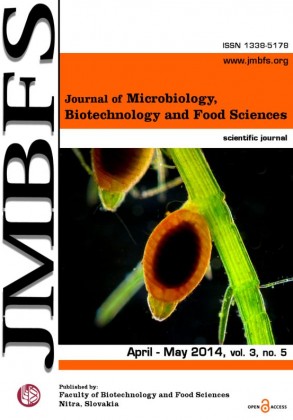THE SACCHARIDE PROFILE OF POLISH HONEYS DEPENDING ON THEIR BOTANICAL ORIGIN
Keywords:
Honey, monosaccharide, HPLC, optical activity, reflectometric test, botanical originAbstract
Thirty honey samples (18 monofloral, 6 multifloral and 6 honeydew) were collected directly from apiaries localized in the South-Eastern Poland. Monosaccharide profiles (glucose/fructose ratio) in honey were examined by HPLC method with ELSD-detection. The results were compared with other parameters used in honey sugar analysis, i.e. a level of reducing sugars measured by Lane-Eynon, sugar extract (refractometric), specific rotation angle and glucose content determined with Reflectoquant® test (Merck). Moreover, some physicochemical parameters such as: water content, free acids and HMF content by White method were tested.The content of monosaccharides determined by HPLC (as sum of glucose and fructose) and Lane-Eynon methods were compared (r=0.83) and changed from 68% in rape honey to 78% on average in goldenrod honey. All studied honeys showed the ratio of fructose/glucose above 1.5. The measurement of the specific optical rotation allowed to distinguish nectar (-) and honeydew (+) honey, but due to the heterogeneity of the results, they could not be used for identification of the floral honeys. The results of reflectometric test for glucose level were positively correlated with values measured by HPLC method (r=0.73).
Downloads
Download data is not yet available.
Downloads
Published
2014-04-01
How to Cite
S., Z., M., W., M., B., J., K., & M., D. (2014). THE SACCHARIDE PROFILE OF POLISH HONEYS DEPENDING ON THEIR BOTANICAL ORIGIN. Journal of Microbiology, Biotechnology and Food Sciences, 3(5), 387–390. Retrieved from https://office2.jmbfs.org/index.php/JMBFS/article/view/7000
Issue
Section
Food Sciences
License
Copyright (c) 2014 Zielińska S., Wesołowska M., Bilek M., Kaniuczak J., Dżugan M.

This work is licensed under a Creative Commons Attribution 4.0 International License.
All papers published in the Journal of Microbiology, Biotechnology and Food Sciences are published under a CC-BY licence (CC-BY 4.0). Published materials can be shared (copy and redistribute the material in any medium or format) and adapted (remix, transform, and build upon the material for any purpose, even commercially) with specifying the author(s).

